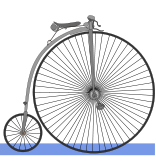The Geologic Time Scale: Introduction

Click to see the |
A Timeline of Earth’s History
Click the image to the right to see the evolution of the bicycle. You have probably seen timelines like this before. They represent times in history and help you place events in chronological order and assign numerical dates to them. In this case, it helps you visualize how bicycles have changed over time. Timelines are often constructed to scale, so that one inch equals a decade or a century, etc. As you learned in the previous section, Earth has been radiometrically dated to be 4.65 billion years old.
Could you make a scaled-down timeline of all of Earth history? If you made a timeline of all of Earth’s history and had just one millimeter represent every year in geologic history, then the entire timeline would be about 2,858 miles in length. Dinosaurs would appear on the timeline at about 100 miles, and a 16-year old person would appear in the last half of an inch. Yet having some kind of visual representation of geologic time is useful for studying the history of Earth and its life forms. Like the bicycle timeline above, it can provide you with a snapshot view of how change has taken place.
In this section, you will learn about the geologic time scale, which is a visualization model that helps you group chunks of time, and see how things have changed with the passage of millions and billions of years.